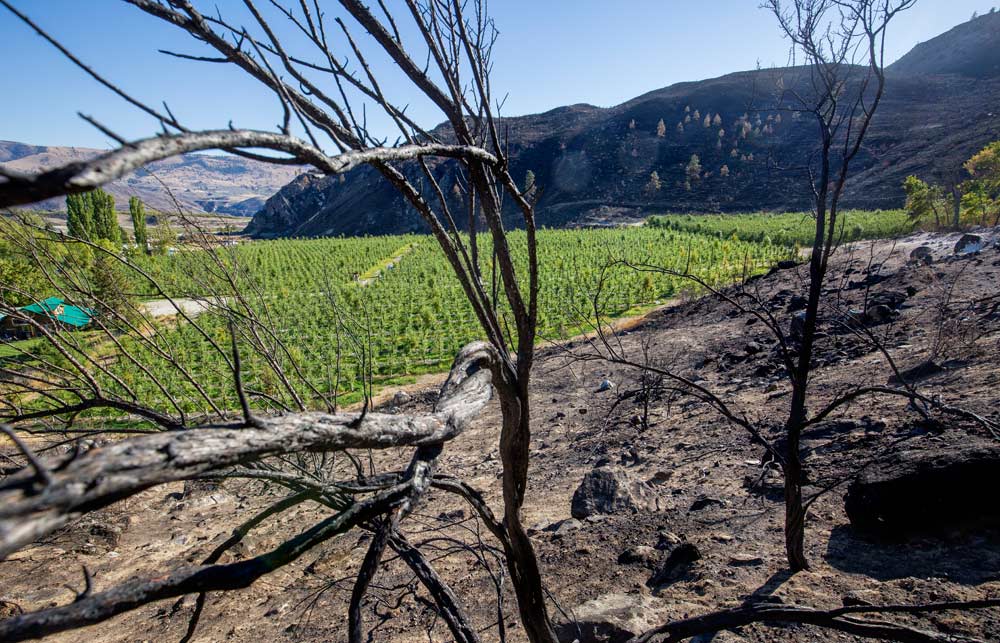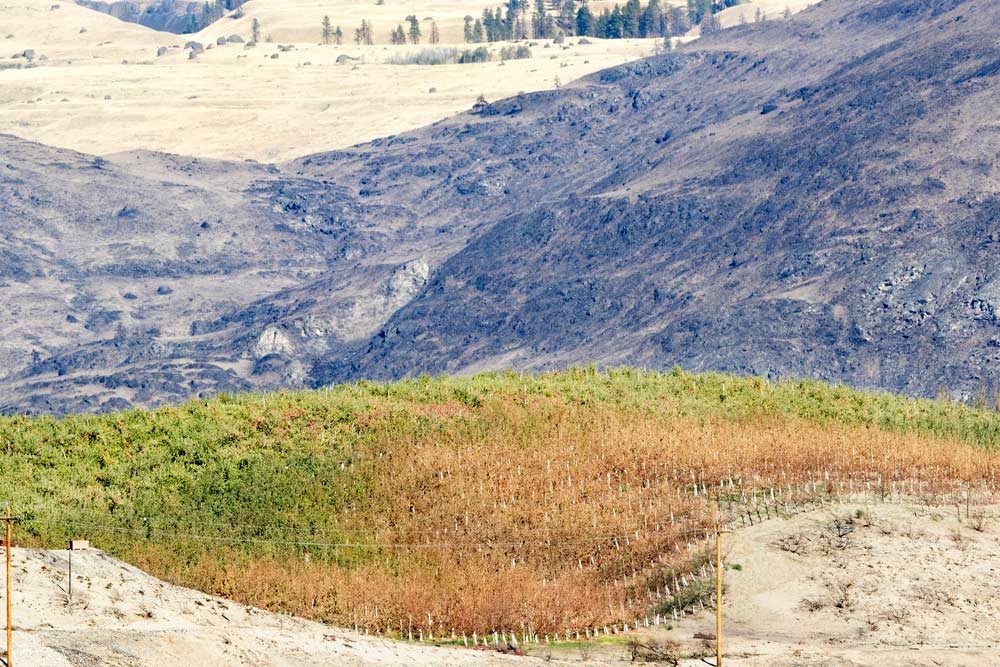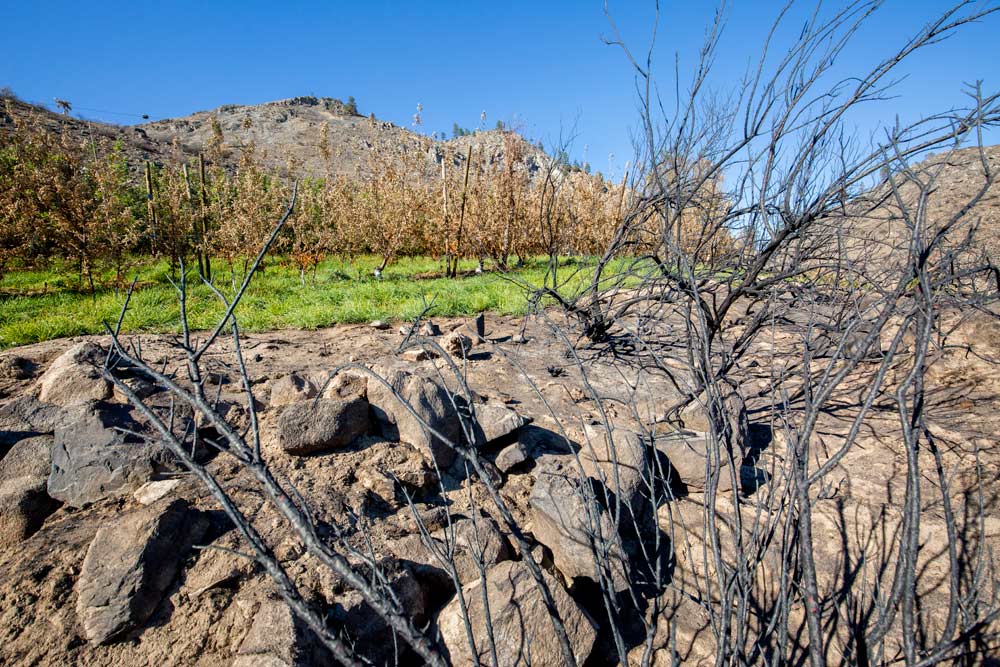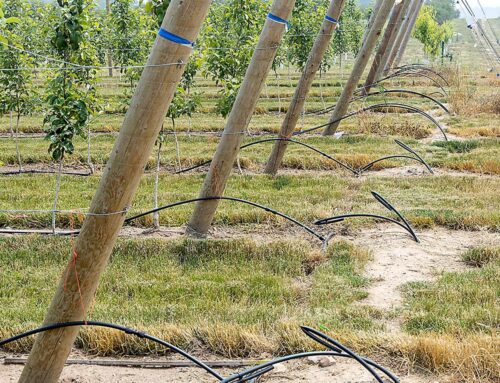
Several orchards scorched by the 2015 Chelan complex fire were in difficult to navigate, rough terrain, surrounded by brush and trees in relatively unmanaged lands. This canyon in Chelan shows one of Robison Orchard’s blocks that suffered wildfire damage during that fire after steep, unusable areas covered in brush burned, scorching second leaf apple rows bordering the access roads. (TJ Mullinax/Good Fruit Grower)
In the arid West, summer wildfires are an annual concern, and with them comes the usual advice to maintain defensible space: trim shrubs, remove lower limbs and keep grounds clean and green.
Most of the advice centers on protecting structures like houses and shops, but wildfire can damage orchards, too, and forestry and fire experts have been spreading the fire prevention message among growers whose farms border undeveloped properties such as forests and shrub-steppe land.
“A lot of times, they’re not manicured,” said Doug Thiesies, Hood River, Oregon, county forest manager. “Nobody pays attention to that very much.”
The Hood River area, one of the Northwest’s prolific cherry and pear growing regions, dealt with forest fires in late summer and fall 2017. The Eagle Creek Fire alone consumed 49,000 acres, flames coming to within a half-mile of orchards before rain finally slowed its progress.
“Probably another day or two and we would have been burned,” Thiesies said. As a response, Oregon State University forestry professors led workshops for orchardists.
Not surprisingly, much of the advice for protecting structures rings true for fruit trees. If orchards border forest lands, growers should cut back shrubs, thin small trees and remove limbs on big trees up to 20 feet high on property they own. In a shrub-steppe region, mow grasses, remove tumbleweeds piled up against fences and windbreaks and maintain enough room for vehicle access around the orchard.
“It’s not rocket science,” said Rudy Prey, a Cashmere, Washington, pear grower who pays his crews for some fire prevention work every year on his property bordered by forest. Prey also mounts sprinklers to his game fence to keep the brush damp.

The intensity of the fire that damaged Collins’ orchard scorched apples on the tree, burned trellis components and melted reflective mylar in between the tree rows. (TJ Mullinax/Good Fruit Grower)
No measures can completely fireproof an orchard. A 50-foot buffer zone with a disced firebreak won’t stop some large blazes. Embers sometimes float for miles before spotting new fires; last year’s Eagle Creek Fire jumped the mighty Columbia River, the largest waterway in the Pacific Northwest.
Usually, irrigated orchards are safe, but the sheer heat from a nearby wildfire can damage or kill trees two to three rows in. That happened in Washington growing regions in Chelan, Pateros and Brewster in the record-setting fire seasons of 2014 and 2015.
In 2015, a wildfire damaged three rows on the downhill side of a 12-acre block of immature Envy apple trees owned by Jake Robison’s family in Chelan, in spite of a 10- to 15-foot irrigated grass buffer he keeps for vehicle access. Fire destroyed the first row, about 300 trees or more that needed to be replanted. Row two recovered but lost a year of production.
The same fire destroyed Chelan Fruit’s packing facility.
Robison doesn’t suspect he will do anything different on that block. It sits on a plateau against a steep hill. Mowing beyond the fence line would require prohibitively expensive hand labor. On the other hand, the family extends preventative mowing up to 50 feet beyond the boundary elsewhere on their property where the ground is flat.
“It is a gamble,” Robison said. “It’s kind of a calculated risk.”
In Reggie Collins’ orchard, gusting winds blew flames 12 rows into one of his blocks. Collins has since replanted but decided to stay back another 20 feet from the edge of his property, which cost him a row of trees. He also mows and trims brush more often surrounding the block. Another fire burned the same ground last year but did little damage due to the lack of fuels. That has him considering controlled burns on his property in the future, something that would require a permit from the county.
Other than that, there is only so much he can do. “There’s not a whole lot we as growers can change on this,” he said.
Collins is the CEO of Chelan Fruit but the fire damaged his personal farm, named Grover Collins Orchards after his late father. He recommends growers know what is covered by their insurance policies.

One of Reggie Collins’ apple orchards where wind fed flames burned up to 12 rows of young trees along the Columbia River in Chelan, Washington, during the 2015 Chelan complex fire. (TJ Mullinax/Good Fruit Grower)
Not alone
A brush fire in the 1990s cost Jim Doornink four or five rows of fruit trees on his Rattlesnake Ridge orchard near Wapato, Washington.
Doornink typically mows down weeds, burns away loose brush and sets controlled burns in the low-risk season. He did all those things that year, but did not disc a firebreak like he sometimes does. He even had a chance when he saw the fires on the horizon. He figured the fire was far away and he had trucks and manpower at the ready.
However, before he could change his mind, the wind turned and sent flames 50 feet high rushing at him.
“We learned a big lesson that year,” he said.
It’s one thing to manage your own property, but for preventative measures to work, they sometimes require a neighborhood approach.
Doornink suggests reviewing county maps and asking neighbors for permission to extend brush removal and discing to their land.
The neighborhood approach was one of the main messages of Glenn Ahrens, the Oregon State University forester who led the fall workshops. “It’s important for communities to come together. That’s where the real work needs to be done.”
There is financial help for it, too. Both the Washington Department of Natural Resources and the Oregon Department of Forestry write grants for federal money to take protective measures on private property.
In the last 10 years, Mel Gard, the National Fire Plan coordinator for the Oregon Forestry Department in The Dalles, estimates he has steered between $6 million and $7 million in federal funds to that end in Hood River and Wasco counties, both in the Columbia Gorge. Conservation districts sometimes do the same, he said.
The money typically goes to forested property, but not always, said Scott Chambers, the land owner assistant program manager for the Washington Department of Natural Resources Southeast region in Ellensburg.
Doug Fowler, a former logging company owner turned orchardist, stressed that any community efforts should continue beyond the initial work to do any good. “It’s difficult to have a long-term, sustained fuel reduction program on land you don’t own,” he said. •

At this young second leaf Envy apple block at Robison Orchard, several rows of trees were lost when the Chelan complex fire burned through brush and trees growing on steep, rocky terrain bordering the orchard. (TJ Mullinax/Good Fruit Grower)
Keeping wildfires out of the orchard
Growers and state forestry officials offer the following tips for preventing wildfires from burning orchards:
—Keep orchards clear of cardboard and paper. Anything a match could ignite, a flying ember could ignite.
—Periodically mow grasses and cut back shrubs around perimeter.
—Thin trees, removing small and sick ones, in the fall after bark beetles have left the area. Leave enough for erosion control.
—Cut off lower limbs on tall trees up to 20 feet to prevent a ground fire from reaching the tree canopy.
—Leave a good 5 feet between the canopies of each tree.
—Burn slash piles in the spring; don’t leave them through summer, when embers could ignite them.
—Light a controlled burn every few years.
—Put sprinklers on your game fence to keep the perimeter grounds wet and green. Then be even more vigilant about mowing the extra vegetation.
—In the dry season, consider turning on micro sprayers to wet down the drive-rows, even if you use drip irrigation on your trees.
—Leave an access path for vehicles surrounding your orchard.
—Remove or destroy prunings, don’t just toss them around the orchard perimeter.
—Monitor controlled burn piles carefully. They sometimes escape and start wildfires.
—Remove tumbleweeds and bitterbrush that blow against fences and windbreaks.
—Disc a firebreak around your orchard.
—If planting a new orchard, consider leaving extra space around it for fire control. A few feet of productive ground may be worth the extra fire protection.
—Talk to neighbors to ask permission to do some fire control activities on their land.
—Find out if there’s already a coordinated fire plan in your community.
—Contact state resource agencies about financial help to work on your land or neighbor’s land. They manage federal grant money for fire control under the National Fire Plan.
—by Ross Courtney






Hello! When I went back to my hometown a couple of weeks ago, I spotted an orchard which has been totally mismanaged without any proper safety measure. Luckily, you were here to tell us that establishing a firebreak area around our land can at least deter the advancement of minor fires. I’ll make sure the owner is made aware about this matter so the place can stay intact.